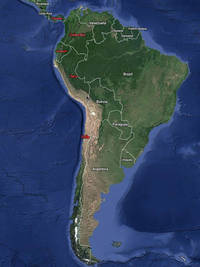BIOSPHERE RESERVES AS A TOOL FOR COASTAL AND ISLAND MANAGEMENT IN THE SOUTH- EAST PACIFIC REGION (BRESEP)
see the BRESEP movie
The objective of the BRESEP Project is to create and strengthen existing biosphere reserves, as a tool of sound innovative practices from a social, cultural and environmental viewpoint, in coastal zones and islands in the Pacific region in Chile, Colombia, Ecuador, Panama and Peru. This project brings added value to local socio-economic activities and in this way, improve livelihoods of the region's population.
BRESEP aims to build the capacities of the actors involved and create a collaborative network between the five participating countries to compare information, knowledge and experience on themes such as the loss of biodiversity, marine and coastal management, and improvement in the standard of living of the population through local, sustainable socio-economic activities.
Background
 The coastal zone and marine environments of South-East Pacific countries (Chile, Colombia, Ecuador, Panama, and Peru) host an enormous diversity of life, and play an important role in each of these countries’ economies.
The coastal zone and marine environments of South-East Pacific countries (Chile, Colombia, Ecuador, Panama, and Peru) host an enormous diversity of life, and play an important role in each of these countries’ economies.
The west coast, from southern Chile to northern Peru, is associated with the Humboldt Current – one of the world’s most productive Large Marine Ecosystems (LME), representing approximately 18-20% of the global fish catch and hosting globally significant biodiversity (Heileman et al., 2009).
Ecuador, Colombia and Panama are part of the Pacific-Central American Coastal LME, which covers a surface area of nearly 2 million km2, of which 1.42% is protected. The Pacific-Central American Coastal LME is considered a high productivity ecosystem, rich in both pelagic and demersal fisheries (op cit.).
The various human land-based activities, including agriculture, aquaculture, tourism, urban development, mining, industry and marine-based activities (marine shipping with its fuel spills and ballast water dumping) have significant direct and indirect effects on the marine coastal environment of the South-East Pacific. These activities provide an important source of employment and vital socio-economic benefits, yet also inflict environmental degradation (CPPS and UNEP, 2001).
Map data ©2014 Inav/Geosistemas SLR Imagery ©2014 NASA Terra Metrics
BRESEP Project countries: Chile, Colombia, Ecuador, Panama and Peru
Furthermore, the region is regularly subjected to the El Niño-Southern Oscillation (ENSO) phenomenon, which produces dramatic upheavals in local, and ultimately global, climatic weather conditions. This affects marine ecosystems and human livelihoods, in addition to creating enormous social and economic impacts (UNEP, 2005).
UNESCO's Man and the Biosphere Programme encourages countries to establish biosphere reserves in order to promote a sustainable development based on local community efforts and sound science. There are currently 669 biosphere reserves in 120 countries; more than 200 of which are located on islands and coastal areas. There are currently 9 biosphere reserves along the Pacific coast of South America, two of which have exceptional practices worth sharing through this project: Archipiélago de Colón (Galápagos) in Ecuador and Cabo de Hornos in Chile.
Objectives
The three main objectives of this project are:
- the creation and reinforcement of existing biosphere reserves on the coastal areas and islands of the west coast of Chile, Colombia, Ecuador, Panama and Peru;
- the promotion of biosphere reserves as tools for innovative projects to bring added value to local socio-economical activities;
- awareness-raising and capacity building of all concerned stakeholders in the area.
Outcomes of the collaboration between BRESEP and SPINCAM on the South Pacific Coast of Latin America